| Magnolia tripetala | |
|---|---|
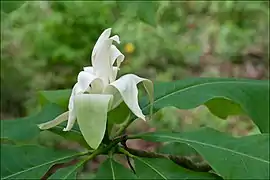 | |
| Scientific classification | |
| Kingdom: | Plantae |
| Clade: | Tracheophytes |
| Clade: | Angiosperms |
| Clade: | Magnoliids |
| Order: | Magnoliales |
| Family: | Magnoliaceae |
| Genus: | Magnolia |
| Subgenus: | Magnolia subg. Magnolia |
| Section: | Magnolia sect. Rhytidospermum |
| Subsection: | Magnolia subsect. Rhytidospermum |
| Species: | M. tripetala |
| Binomial name | |
| Magnolia tripetala | |
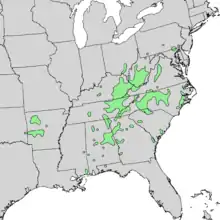 | |
| Generalized natural range of Magnolia tripetala | |
| Synonyms[2][3][4] | |
Magnolia tripetala, commonly called umbrella magnolia or simply umbrella-tree, is a deciduous tree native to the eastern United States in the Appalachian Mountains, the Ozarks, and the Ouachita Mountains. The name "umbrella tree" derives from the fact that the large leaves are clustered at the tips of the branches forming an umbrella-shaped structure.
Description
Umbrella magnolias have large shiny leaves 30–50 cm long, spreading from stout stems. In a natural setting the umbrella magnolia can grow 15 m tall. The flowers are large, appear in the spring, malodorous,[5] 15–25 cm diameter, with six to nine creamy-white tepals and a large red style, which later develops into a red fruit (an aril) 10 cm long, containing several red seeds. These trees are attractive and easy to grow. The leaves turn yellow in the autumn. The leaves are clustered at the tip of the stem with very short internodes. The tree has reddish cone-shaped fruit, is shade tolerant, has shallow spreading roots, and is pollinated by beetles.
Reproduction
It has been found that M. tripetala when cultivated can produce pollen at a low viability rate (9.4-31.7%). Real seed productivity of the taxa being studied is less than their potential productivity. However, M. tripetala are characterized by a high seed germinating ability, of up to 94%. Optimal germination conditions for seeds of M. tripetala require protected ground or a greenhouse and stratification at 4ºC during 30 days. [6]
Notable trees
The largest known Magnolia tripetala is 15.2 m in height with a trunk diameter of 87 cm in Bucks County, Pennsylvania.[5]
Uses
Magnolia tripetala contains a substance called ethyl acetate in its branches, and this substance displays nematicidal activity.[7] This activity allows it to specifically fight against Bursaphelenchus xylophilus, Panagrellus redivivus, and Caenorhabditis elegans.[8]
Gallery
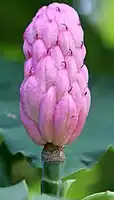 Immature fruit
Immature fruit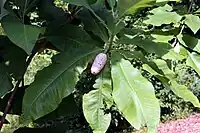 Immature fruit and leaf details
Immature fruit and leaf details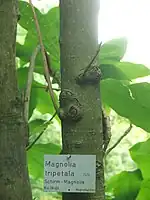 Tree
Tree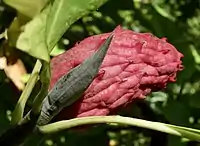 Nearly mature fruit
Nearly mature fruit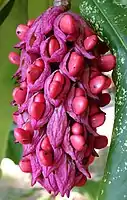 Mature fruit with seeds
Mature fruit with seeds Seedling
Seedling
References
- ↑ Khela, S.; Wheeler, L.; Rivers, M.C. (2014). "Magnolia tripetala". IUCN Red List of Threatened Species. 2014: e.T194013A2294339. doi:10.2305/IUCN.UK.2014-3.RLTS.T194013A2294339.en. Retrieved 19 November 2021.
- 1 2 Magnolia tripetala was published in Systema Naturae Editio Decima 2: 1082. 1759. The binomial was derived from its basionym, Magnolia virginiana var. tripetala "Name - Magnolia tripetala (L.) L." Tropicos. Saint Louis, Missouri: Missouri Botanical Garden. Retrieved June 7, 2011.
- ↑ "Magnolia tripetala (L.) L." The Plant List; Version 1. (published on the internet). 2010. Retrieved June 7, 2011.
- ↑ Magnolia virginiana var. tripetala, the basionym to M. tripetala was originally described and published in Species Plantarum 1: 536. 1753. "Name - Magnolia virginiana var. tripetala L." Tropicos. Saint Louis, Missouri: Missouri Botanical Garden. Retrieved June 7, 2011.
- 1 2 "Magnolia tripetala". Flora of North America. Retrieved 8 November 2015.
- ↑ Kameneva, L. A., & Koksheeva, I. M. (2013). Reproductive biology of seven taxa of Magnolia L. in the south of Russian Far East. Bangladesh Journal of Plant Taxonomy, 20(2), 163–170. https://doi.org/10.3329/bjpt.v20i2.17390
- ↑ Ntalli, N. G., & Caboni, P. (2012). Botanical nematicides: a review. Journal of agricultural and food chemistry, 60(40), 9929-9940.
- ↑ Ntalli, N. G., & Caboni, P. (2012). Botanical nematicides: a review. Journal of agricultural and food chemistry, 60(40), 9929-9940.
